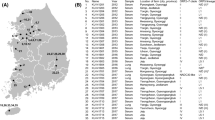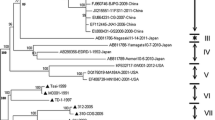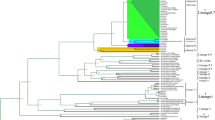Abstract
The full-length glycoprotein 5 (GP5) gene and a partial nonstructural protein 2 (NSP2) gene fragment of 46 porcine reproductive and respiratory syndrome viruses (PRRSV) from pig farms in southeastern China between 2004 and 2007 were sequenced for phylogenetic analysis. All of the PRRSV isolates in this study were of the North American type, and the majority of them were clustered in subgroup II and had 84.1–89.1% amino acid sequence identity to those of subgroup I including the North American strain VR-2332. Three variable regions containing epitopes A and B in the N-terminal region were identified and found to be under positive selection. Several additional mutations, which were also located in the variable regions, were seen in isolates from the years 2006 and 2007 in subgroup II, as compared with those of earlier years (2004–2005) in the same group. Further analysis revealed that the majority of the subgroup II PRRSV isolates prevalent in the region since 2004 had thirteen mutation sites that distinguished them from subgroup I strains, indicating a possible introduction of a certain strain from the same source in the region or elsewhere well before 2004. A 29-aa deletion in the NSP2 fragment was found in PRRSV isolates as early as in 2005, one year earlier than the virulent PRRSV with the same deletion became dominant in China. Taken together, this study shows that subgroup II PRRSV strains with a partial deletion of nsp2 are currently prevailing in southeastern China.



Similar content being viewed by others
References
An TQ, Zhou YJ, Liu GQ, Tian ZJ, Li J, Qiu HJ, Tong GZ (2007) Genetic diversity and phylogenetic analysis of glycoprotein 5 of PRRSV isolates in mainland China from 1996 to 2006: coexistence of two NA-subgenotypes with great diversity. Vet Microbiol 123:43–52
Andreyev VG, Wesley RD, Mengeling WL, Vorwald AC, Lager KM (1997) Genetic variation and phylogenetic relationships of 22 porcine reproductive and respiratory syndrome virus (PRRSV) field strains based on sequence analysis of open reading frame 5. Arch Virol 142:993–1001
Bilodeau R, Dea S, Sauvageau RA, Martineau GP (1991) ‘Porcine reproductive and respiratory syndrome’ in Quebec. Vet Rec 129:102–103
Cha SH, Choi EJ, Park JH, Yoon SR, Song JY, Kwon JH, Song HJ, Yoon KJ (2006) Molecular characterization of recent Korean porcine reproductive and respiratory syndrome (PRRS) viruses and comparison to other Asian PRRS viruses. Vet Microbiol 117:248–257
Chen J, Liu T, Zhu CG, Jin YF, Zhang YZ (2006) Genetic variation of Chinese PRRSV strains based on ORF5 sequence. Biochem Genet 44:425–435
Chen N, Hu H, Zhang Z, Shuai J, Jiang L, Fang W (2008) Genetic diversity of the envelope glycoprotein E2 of classical swine fever virus: recent isolates branched away from historical and vaccine strains. Vet Microbiol 127:286–299
Fang Y, Schneider P, Zhang WP, Faaberg KS, Nelson EA, Rowland RR (2007) Diversity and evolution of a newly emerged North American Type 1 porcine arterivirus: analysis of isolates collected between 1999 and 2004. Arch Virol 152:1009–1017
Feng YJ, Zhao TZ, Nguyen T, Inui K, Ma Y, Nguyen TH, Nguyen VC, Liu D, Bui QA, To LT, Wang CB, Tian KG, Gao GF (2008) Porcine respiratory and reproductive syndrome virus variants, Vietnam and China, 2007. Emerg Infect Dis 14:1774–1776
Forsberg R, Storgaard T, Nielsen HS, Oleksiewicz MB, Cordioli P, Sala G, Hein J, Botner A (2002) The genetic diversity of European type PRRSV is similar to that of the North American type but is geographically skewed within Europe. Virology 299:38–47
Grenfell BT, Pybus OG, Gog JR, Wood JL, Daly JM, Mumford JA, Holmes EC (2004) Unifying the epidemiological and evolutionary dynamics of pathogens. Science 303:327–332
Han J, Wang Y, Faaberg KS (2006) Complete genome analysis of RFLP 184 isolates of porcine reproductive and respiratory syndrome virus. Virus Res 122:175–182
Han J, Liu G, Wang Y, Faaberg KS (2007) Identification of nonessential regions of the nsp2 replicase protein of porcine reproductive and respiratory syndrome virus strain VR–2332 for replication in cell culture. J Virol 81:9878–9890
Key KF, Haqshenas G, Guenette DK, Swenson SL, Toth TE, Meng XJ (2001) Genetic variation and phylogenetic analyses of the ORF5 gene of acute porcine reproductive and respiratory syndrome virus isolates. Vet Microbiol 83:249–263
Kosakovsky Pond SL, Frost SDW (2005) Not so different after all: a comparison of methods for detecting amino acid sites under selection. Mol Biol Evol 2:1208–1222
Larochelle R, D’Allaire S, Magar R (2003) Molecular epidemiology of porcine reproductive and respiratory syndrome virus (PRRSV) in Quebec. Virus Res 96:3–14
Lopez OJ, Osorio FA (2004) Role of neutralizing antibodies in PRRSV protective immunity. Vet Immunol Immunopathol 102:155–163
Mardassi H, Massie B, Dea S (1996) Intracellular synthesis, processing, and transport of proteins encoded by ORFs 5 to 7 of porcine reproductive and respiratory syndrome virus. Virology 221:98–112
Meng XJ (2000) Heterogeneity of porcine reproductive and respiratory syndrome virus: implications for current vaccine efficacy and future vaccine development. Vet Microbiol 74:309–329
Meulenberg JJ, Hulst MM, de Meijer EJ, Moonen PL, den Besten A, de Kluyver EP, Wensvoort G, Moormann RJ (1993) Lelystad virus, the causative agent of porcine epidemic abortion and respiratory syndrome (PEARS), is related to LDV and EAV. Virology 192:62–72
Nei M, Gojobori T (1986) Simple methods for estimating the numbers of synonymous and nonsynonymous nucleotide substitutions. Mol Biol Evol 3:418–426
Nelsen CJ, Murtaugh MP, Faaberg KS (1999) Porcine reproductive and respiratory syndrome virus comparison: divergent evolution on two continents. J Virol 73:270–280
Oleksiewicz MB, Botner A, Toft P, Normann P, Storgaard T (2001) Epitope mapping porcine reproductive and respiratory syndrome virus by phage display: the nsp2 fragment of the replicase polyprotein contains a cluster of B-cell epitopes. J Virol 75:3277–3290
Ostrowski M, Galeota JA, Jar AM, Platt KB, Osorio FA, Lopez OJ (2002) Identification of neutralizing and nonneutralizing epitopes in the porcine reproductive and respiratory syndrome virus GP5 ectodomain. J Virol 76:4241–4250
Pesch S, Meyer C, Ohlinger VF (2005) New insights into the genetic diversity of European porcine reproductive and respiratory syndrome virus (PRRSV). Vet Microbiol 107:31–48
Pesente P, Rebonato V, Sandri G, Giovanardi D, Ruffoni LS, Torriani S (2006) Phylogenetic analysis of ORF5 and ORF7 sequences of porcine reproductive and respiratory syndrome virus (PRRSV) from PRRS-positive Italian farms: a showcase for PRRSV epidemiology and its consequences on farm management. Vet Microbiol 114:214–224
Plagemann PG, Rowland RR, Faaberg KS (2002) The primary neutralization epitope of porcine respiratory and reproductive syndrome virus strain VR-2332 is located in the middle of the GP5 ectodomain. Arch Virol 147:2327–2347
Rowland RR, Steffen M, Ackerman T, Benfield DA (1999) The evolution of porcine reproductive and respiratory syndrome virus: quasispecies and emergence of a virus subpopulation during infection of pigs with VR-2332. Virology 259:262–266
Tian K, Yu X, Zhao T, Feng Y, Cao Z, Wang C, Hu Y, Chen X, Hu D, Tian X, Liu D, Zhang S, Deng X, Ding Y, Yang L, Zhang Y, Xiao H, Qiao M, Wang B, Hou L, Wang X, Yang X, Kang L, Sun M, Jin P, Wang S, Kitamura Y, Yan J, Gao GF (2007) Emergence of fatal PRRSV variants: unparalleled outbreaks of atypical PRRS in China and molecular dissection of the unique hallmark. PLoS ONE 2:e526
Wensvoort G, Terpstra C, Pol JM, ter Laak EA, Bloemraad M, de Kluyver EP, Kragten C, van Buiten L, den Besten A, Wagenaar F (1991) Mystery swine disease in The Netherlands: the isolation of Lelystad virus. Vet Q 13:121–130
Yan Y, Guo X, Ge X, Chen Y, Cha Z, Yang H (2007) Monoclonal antibody and porcine antisera recognized B-cell epitopes of Nsp2 protein of a Chinese strain of porcine reproductive and respiratory syndrome virus. Virus Res 126:207–215
Yoshii M, Kaku Y, Murakami Y, Shimizu M, Kato K, Ikeda H (2005) Genetic variation and geographic distribution of porcine reproductive and respiratory syndrome virus in Japan. Arch Virol 150:2313–2324
Yuan S, Murtaugh MP, Schumann FA, Mickelson D, Faaberg KS (2004) Characterization of heteroclite subgenomic RNAs associated with PRRSV infection. Virus Res 105:75–87
Zhou YJ, Hao XF, Tian ZJ, Tong GZ, Yoo D, An TQ, Zhou T, Li GX, Qiu HJ, Wei TC, Yuan XF (2008) Highly virulent porcine reproductive and respiratory syndrome virus emerged in China. Transbound Emerg Dis 55:152–164
Acknowledgments
This work is part of the project supported by Zhejiang Provincial Department for Science and Technology, China (Project No. 2007C12072).
Author information
Authors and Affiliations
Corresponding author
Rights and permissions
About this article
Cite this article
Hu, H., Li, X., Zhang, Z. et al. Porcine reproductive and respiratory syndrome viruses predominant in southeastern China from 2004 to 2007 were from a common source and underwent further divergence. Arch Virol 154, 391–398 (2009). https://doi.org/10.1007/s00705-009-0316-x
Received:
Accepted:
Published:
Issue Date:
DOI: https://doi.org/10.1007/s00705-009-0316-x




